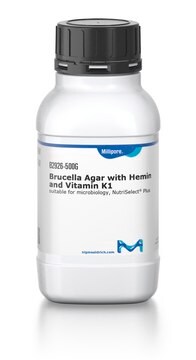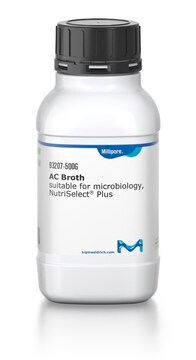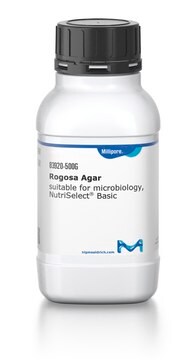W1761
Wilkins Chalgren anaerobic agar
suitable for microbiology, NutriSelect® Plus
About This Item
Recommended Products
sterility
non-sterile
Quality Level
form
powder
shelf life
limited shelf life, expiry date on the label
manufacturer/tradename
NutriSelect® Plus
technique(s)
microbiological culture: suitable
final pH
7.1±0.2 (25 °C)
application(s)
cleaning products
clinical testing
cosmetics
food and beverages
personal care
microbiology
suitability
anaerobic bacteria
selective for Bacteroides spp.
selective for Bifidobacterium spp.
selective for Clostridium spp.
Application
Components
Casein enzymatic hydrolysate, 10.00
Peptic digest of animal tissue, 10.00
Yeast extract, 5.00
Dextrose, 1.00
Sodium chloride, 5.00
L-Arginine, 1.00
Sodium pyruvate, 1.00
Hemin, 0.005
Menadione, 0.0005
Agar, 10.00
Preparation Note
Footnote
The designations basic, plus, or prime are added to indicate the quality control level, from basic quality control to standard QC plus to prime for full regulatory compliance.
Legal Information
Signal Word
Warning
Hazard Statements
Precautionary Statements
Hazard Classifications
Aquatic Chronic 3 - Skin Sens. 1
Storage Class Code
11 - Combustible Solids
WGK
WGK 3
Flash Point(F)
Not applicable
Flash Point(C)
Not applicable
Personal Protective Equipment
Choose from one of the most recent versions:
Already Own This Product?
Find documentation for the products that you have recently purchased in the Document Library.
Customers Also Viewed
Articles
Probiotics are defined as live bacteria with beneficial effects to the health of the host organism. Pimarily lactic acid bacteria (LAB) and bifidobacteria are used as probiotics, however certain yeasts and bacilli are also known to have positive effects
Molecular biology-based methods, like PCR, can be used for lactobacilli detection. However, they are often quite expensive. We provide a revolutionary molecular biology method that is rapid, easy, and cost-effective.
Today, diverse studies report the benefits of probiotics, such as inhibitory effects on pathogens, aid in the management or prevention of chronic intestinal inflammatory diseases or atopic syndromes, and support to the immune system. Potential beneficial applications abound, researchers continue to evaluate the effictiveness and clarify the mechanisms of action of probiotics.
Our team of scientists has experience in all areas of research including Life Science, Material Science, Chemical Synthesis, Chromatography, Analytical and many others.
Contact Technical Service













